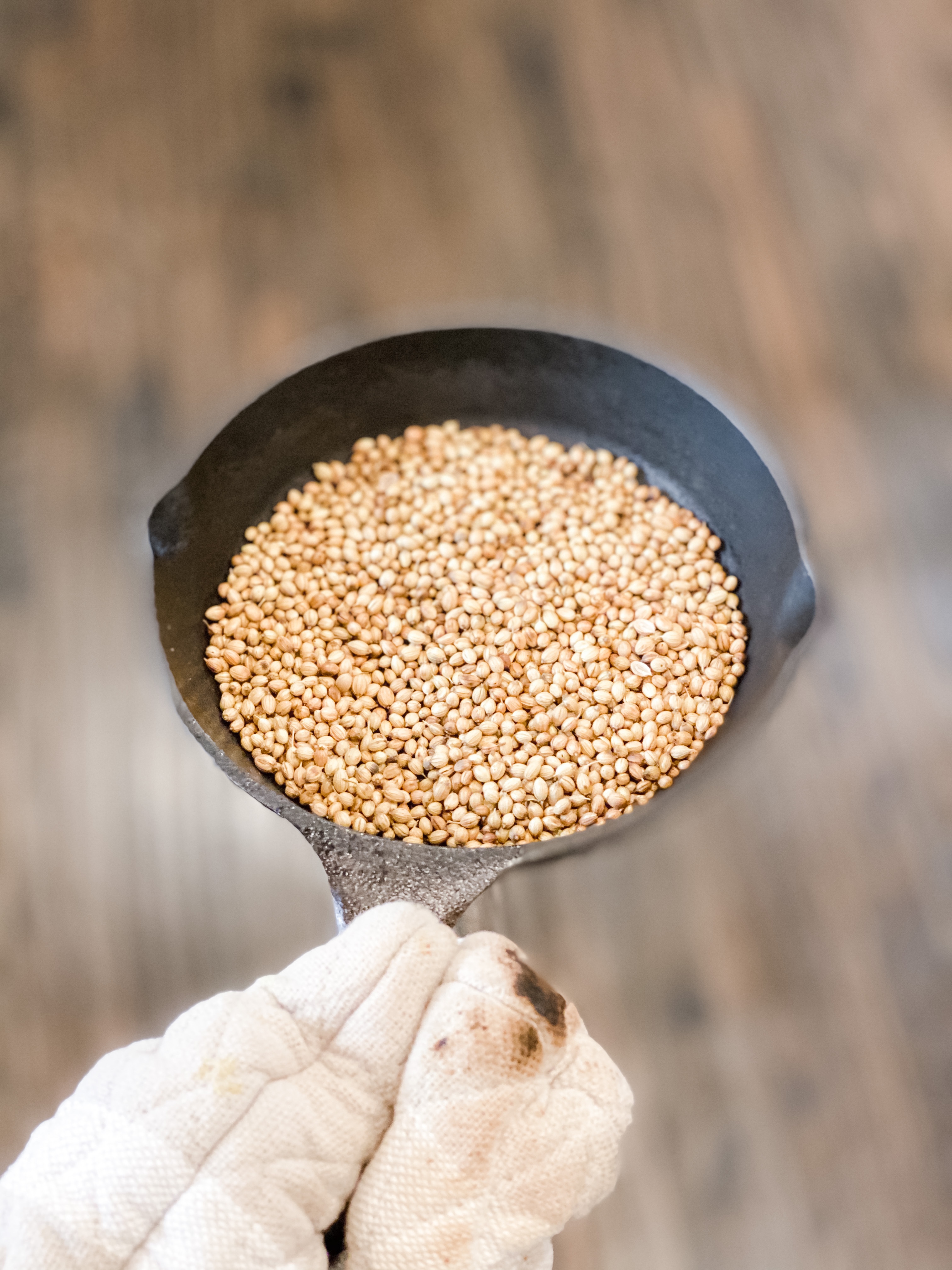
When I left Bangladesh, my cooking skills were close to zero but I was aware of the flavors of most spices. When I first started cooking in the US, even as a novice cook, I could tell that the authentic and original aroma of the spices just did not exist on the prepackaged spice powders and pastes available at the stores. I tried many brands and many stores but never found a difference between prepackaged cumin powder vs coriander powder or garlic paste vs ginger paste. Everything appeared bland. Seriously, is that even possible or were my smell nerves just impaired back then?
Eventually, I switched to grinding whole spices and making pastes at home for cooking. The taste and the aroma of all of dishes elevated tremendously and instantly when using homemade spice mixes. Now, I only buy whole spices and grind them in a coffee grinder or make a paste in a food processor. The time it takes to make the masalas(spices) at home is negligible. I can start the stove and while the pan is heating up, I can grind up some fresh aromatic masala mix. Even if I make a big batch for three or six months and store in an airtight container, I find the fragrance of the spice is hundred times better than the store brought ones.
Garam Masala is an essential spice in a Bengali kitchen. The word “garam masala” translates to “hot spice” though there is nothing hot, such as pepper, in the spice mix. It is a warm and exotic spice mix but not hot in taste. It is a combination of different spices and there are many variations of recipes out there. I found the spice combinations to be different depending on the brand at Bangladeshi or Indian grocery stores in the US. I found store bought mix is slightly different than what I saw my mom using, so I thought I would do a post of garam masala as it is a must spice mix for various meat and rice dishes in my cooking.
The garam masala that I know of consists of cumin, coriander, clove, black cardamom, cinnamon and bay leaf. There are two kinds of cardamom, a green, small kind and a black, bigger than the green kind. I have always seen my mom using the black one in garam masala mix. Also, many recipes call for exotic spices such as mace, nutmeg, etc. which I have always seen my mom using in special dishes but not in everyday garam masala mix.
Garam masala can be used as whole or powder. If used whole, it is tempered in oil in the beginning of cooking whereas the powder form is only sprinkled on the dish during cooking. Stay tuned for some great uses of this masala.
- ½ cup coriander
- ½ cup cumin
- 2-3 stick of cinnamon
- 15-20 cloves
- 7-8 black cardamom
- 2-3 bay leaves
- Break the cinnamon sticks into smaller pieces (optional).
- Dry roast each spices in low medium heat. About 3-4 minutes each stirring continuously to prevent burn.
- Let cool.
- Using a food processor or coffee grinder grind them to dust.
- Store in an air tight container.
I use a manual can opener to break the cinnamon sticks for easier grinding.
Be cautious when roasting so that the spices do not burn.
Garam masala can last 6+ months in an airtight container.




I love Indian spice blends, be it curry or garam masala. I am in Indian food mood these days.
Your photos are just stunning, Lail. And I know your own blending makes the ultimate garam masala!
Thank you for your kind words, Liz.
In the UK, the closest to homemade garam masala that we get is East End brand, so I never tried to make homemade, and even after our move I still buy premade packs. Now your post has inspired me to try, as I was not so sure what to include in the mix! Thanks Lail:-)
You are welcome, Jehanne. The mix is very simple to make. I hope you’ll give it a try and find how the taste and flavor of the dishes elevate instantly.
I don’t think there’s one garam masala recipe out there. The best thing about this spice mix is the ability to custom to each palate.
Love the styling. Spices are so beautiful when styled 🙂
I agree, Kiran. Each kitchen has it’s own customized version of Garam Masala.
A spice blend I use a lot and love! Thanks for the wonderful recipe.
Cheers,
Rosa
Thank you, Rosa.
I buy garam masala, but next time I’m making my own thanks to your recipe!!
It’s so simple and easy. You’ll love the fresh flavors, Nami.
love love love your styling !! awesome
Thanks a lot Simi.
I noticed that you have bay leaves in your masala mix, how do you manage to grind it down to a powder, the last time I tried I had pieces left, so I’m my latest batch I left it out, just adding it in whole at the beginning.
My garam masala is not powder smooth and usually have small pieces of bay leaves. You can probably see few bay leaf pieces in the first picture. Hope this helps.
it does! thanks, I’m going to try it again with bay leaves as soon as I get through my current batch.
So informative and to well written thanks for sharing.
Glad you found it informative. Thank you for stopping by.
Great ideas Lail! I am contemplating buying a spice grinder but I’m really confused as to which brand I should go for. I am looking for something that is suitable for both wet and dry grinding and is easy to clean. Can you suggest one?
Hi Raisa. Thank you.
I use a regular kitchenAid coffee grinder to grind all my dry spices such as garam masala, biryani masala, cumin, coriander, etc., and a cuisinart food processor for wet grinding such as garlic and ginger. I find the small coffee grinder to be very helpful and convenient for my kitchen as I mostly use dry spices. If I ever need to make a wet paste, I just add water to my dry spices after grinding. As for garlic and ginger, I use the food process to paste the spices every 2-3 months. Keep a portion for use in the refrigerator and freeze the remaining in a ziplock bags. Hope this helps.
You’ll find the ones I use on the Ramadan/Eid gift inspiration page on the home section here – http://astore.amazon.com/wiasp-20
thank you so much. That helps me in making a choice!
Lail, thank you for bringing authentic Bangladeshi recipes to English language readers. There are so many Indian Bengali recipes in the internet, and few Bangladeshi Bangali ones. The flavors of each region of India differs, as do the flavors of Bangladesh, which I consider to be even more superb than other Desi cuisines; plus the simpler use of fewer spices more carefully roasted or cooked in oil to enhance their flavor, makes such recipes ideal for newer cooks who are buikding a spice collection. The most delectable Bangladeshi dishes can be prepared with just 2-5 spices, as opposed to the sometimes 20+ spices boasted in some other Desi cuisines. Growing up in NYC I was spoiled by the many “Indian” restaurants eith Bangladeshi chefs, and this began my love for this cuisine. I’m deeply appreciative for your recipes and hope everyone arriving at this site will make many of them and basque in the taste of paradise that Bangladeshi food is to me.
Wishing you good health,
Francesca Pagán
Minnesota, USA